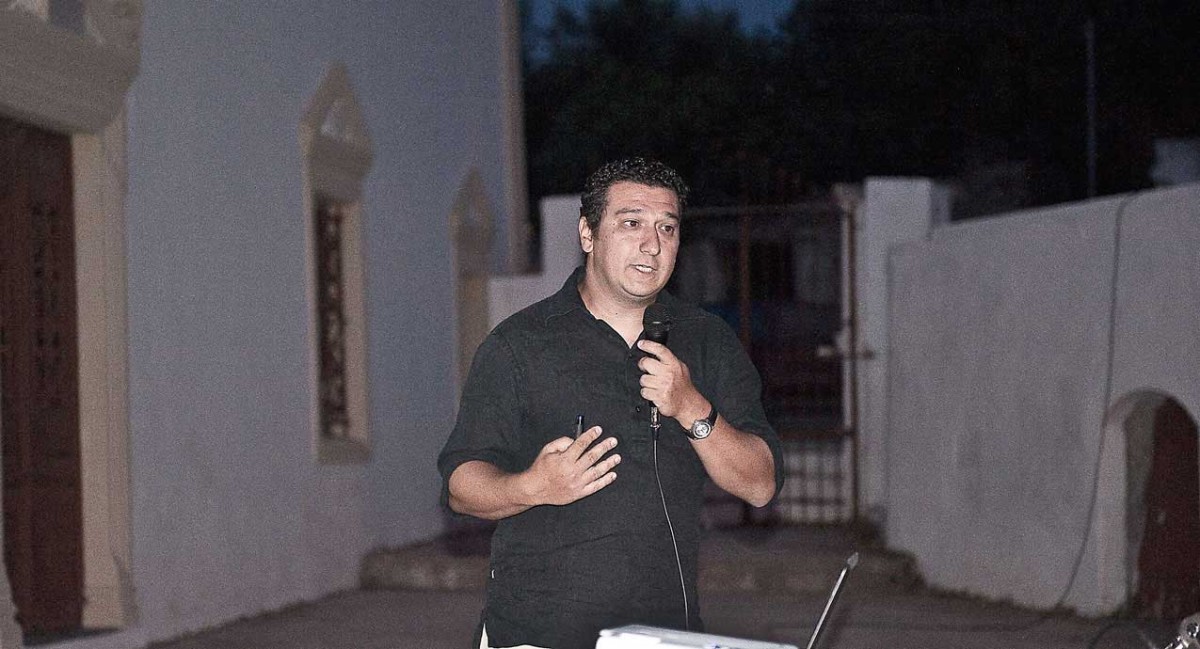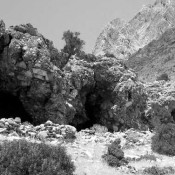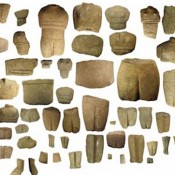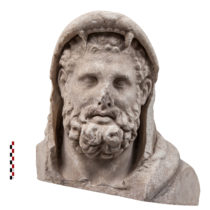Angeliki Rovatsou: Halasarna is the ancient name of modern Kardámaina in southern Kos. In your book you express your gratitude to Georgia Kokkorou-Alevra who has invited you to participate to the Halasarna Survey Project (HSP). What was this project about and how did you get involved in it?
Mercourios Georgiadis: This project is based on the long tradition of research the University of Athens has conducted in the area of Kardamaina on the island of Kos. More particularly the excavation at ancient Halasarna was the trigger in order to study a broader area in which this site belonged. The idea of Prof. G. Kokkorou-Alevra was to conduct a systematic survey within the area of the Demos of the Halasarnitai, as it was known in the Classical and Hellenistic times. The project was funded by the Pythagoras EU scheme and the book was published in 2012 [Mercourios Georgiadis, Kos in the Neolithic and Early Bronze Age. The Halasarna Finds and the Aegean Settlement Pattern, Prehistory Monographs 38, INSTAP Academic Press, Philadelphia, Pennsylvania 2012]. I was invited in 2005 as an expert in the prehistory of the South-eastern Aegean, since I had concluded my PhD and published a relevant monograph in 2003.
A.R.: You have also been fieldwalking in view of creating a Gazetteer of Prehistoric Sites on Kos. Could you describe your experience to us?
M.G.: My original intention was to visit the old sites that were already noted by Hope Simpson and Lazenby in 1970. They have provided the coordinates of the sites and with the help of maps and Google Earth I tried to locate them. The result was often to find other new sites and not the ones reported by the two researchers. The problem was that the coordinates the two scholars provided were based on Italian 2nd War World Maps which are compatible but not identical to the system used by current world-wide coordinates in maps or Google Earth. A difference of a couple of hundred metres to the north and east are enough in order not to find the site you are looking for. Apart from that fieldwalking on Kos is a rather pleasant experience and something I enjoyed a lot.
A.R.: The pottery sherds recovered at Halasarna contained a number of different inclusions in their fabrics. Is this a distinctive feature of the Halasarna sherds?
M.G.: Kos has a large number of clay deposits, several of them of very good quality. Halasarna and areas around it seem to have distinctive features due to the volcanic geology of this area. However, there is a clear techniques employed by potters for making these pots and they are related to these inclusions. There seem to be variations within the different areas on Kos which becomes progressively evident especially during the EBA.
A.R.: Your description of vessels and parts found in the Halasarna survey assemblage is accompanied by a discussion of parallels from elsewhere in the Aegean and Anatolia. Could you please summarize it for us?
M.G.: This was perhaps the most interesting and laborious part of the material analysis. The limited published material from the Neolithic period and the EBA from Kos and the wider Dodecanese did not help and thus material from further afield was sought. Despite the location of Kos very close to the south-western Anatolia, during most of the Neolithic period the material seems to be very much related to the Cyclades, sometimes as much or even more than Rhodes. The similarities in pottery techniques were shared with Anatolia, Cyclades and even Crete, and it is a very important for understanding this period in the Aegean. The close ties of Kos with the Cyclades continued during the EBA, but at the same time more Anatolian trends can be seen, which affected progressively all the Aegean. Beyond the pottery vessels, the similarities with the Cyclades can be seen in the material employed for stone vessels such as marble, andesite and granite. Equally important is the employment of the same copper melting technique at Kos as the one attested in the western Cyclades.
A.R.: “The island of Kos is definitely not isolated –its location lies, rather, at a very strategic point in the Aegean”, you claim in a study aiming at developing “a discourse that is broadly “Aegeocentric” rather than more narrowly “Cycladocentric” in outlook”. Could you expand on it, please?
M.G.: The number of studies, articles, projects and books on the prehistoric Cyclades is rather large in comparison to the rest of the insular regions in the Aegean, with the exception of Crete. Areas like the Dodecanese, the east Aegean islands and the Northern Sporades have attracted significantly less research interest, even when they are put together. Usually there are limited localized studies on particular islands and in most cases their data were used as parallels for practices or finds. What was really missing was a synthesis of the available evidence without having a particular centre within the Aegean Sea. Furthermore, the Aegean is not only the islands with the addition of Crete, but equally the coastal areas surrounding this basin. The influence of mainland Greece and Anatolia are both direct in their coastal zones as well as indirect from further inland.
A.R.: “The Halasarna finds constitute the first body of material covering a period of more than three millennia from a single area”, you write. For defining the dates of sites from the 6th to the late 3rd millennium B.C. you have chosen the terms MN (Middle Neolithic), LN (Late Neolithic) I-II, FN (Final Neolithic) I-II, and EB (Early Bronze) I-III. You also point out that one of the problems in reconstructing the Bronze Age is the geographic and temporal compartmentalization of the Cyclades, Crete and mainland Greece.
M.G.: The available terminology for the Neolithic period is at a stage where more unified system can be still applied in Greece, unlike the case of the later EBA. Although different systems have been proposed, some borrowed from neighboring areas such as Bulgaria and Turkey, a better understanding of the Neolithic period could lead to a meaningful chronological sequence for all parts of Greece.
Any student of archaeology that followed even one module of Aegean prehistory would know that all the Bronze Age in Greece is divided into three regions, the Early Helladic (the southern Greek mainland), the Early Minoan (Crete) and the Early Cycladic. This means that Northern Greece, the Ionian islands and large parts of the insular Aegean are clearly outside this tripartite scheme. Inevitably, for these regions the more generic and spatially-free terms EB I-III would be employed. Moreover, the western Anatolian chronology is analogous in this period, i.e. EB 1-3, but it is not synchronous to the Aegean one. The refinement of dating within the Aegean is a necessity and a challenge, since there are many regional elements that differentiate sites, islands and areas.
A.R.: You reckon that the analysis “of the settlement patterns in the Aegean islands from the Paleolithic to the Early Bronze Age is clearly based upon data that are uneven in coverage of space and time. Still a number of significant diachronic problems may be identified for future research”. Will you please give an example or two?
M.G.: Not many years ago the main hypothesis was that the islands in the Aegean were occupied from the Late Neolithic period onwards, and Crete from the Early Neolithic phase. The more recent excavations at Maroulas on Kythnos, Cyclope’s cave on Youra and Kerame on Ikaria has produced Mesolithic data. Mores systematic research on Crete and Gavdos has also yielded Palaeolithic evidence. These studies have radically changed our view of the Aegean and a new diachronic understanding exists. Still, there are problems like the better understanding of the Early Neolithic and Middle Neolithic phases and the settlement patterns in the island during these periods. Thus, it is difficult to assess the origin and development of the settlement patterns and the material culture more broadly in relation to ones from the better known Late and Final Neolithic periods and even later the Early Bronze Age.
A.R.: Scarce research on the eastern Aegean and the Dodecanese in particular, rare and limited studies of the periods before the Late Bronze Age, the regional compartmentalization commonly applied in discussions of Aegean settlement patterns of the Neolithic and Early Bronze Age: these are the main reasons that prompted you to present a material sequence based on stylistic analysis and to develop a diachronic understanding of settlement dynamics within a wider regional context.
M.G.: Yes. By presenting the settlement pattern identified on Halasarna either on its own or within Kos would have been an important research on its own. I would have used several parallels from other areas to compare and contrast the finds and the sites from this region. However, I would have presented another compartmentalized study restricted to this particular island or the Dodecanese. My intention was to place Halasarna and Kos in its real context, which is the broader Aegean.
A.R.: You are placing the prehistoric settlements identified by the HSP within their spatial and temporal Aegean framework. You are considering the evidence and theories that have informed current concepts about pre-Neolithic and Neolithic use of the Aegean islands. And finally, you are presenting a synthetic consideration of long-term developments in the Halasarna area in their wider Aegean context.
M.G.: The aim was to provide the HSP evidence in its context and through this to provide a synthetic view of the contemporary Aegean. However, it became clear that the earlier periods could not be neglected since there are important trends affecting the later Neolithic and EBA phases. Furthermore, I considered this attempt as a good start for opening a new discussion on wider issues regarding the Aegean Sea during the earlier prehistoric periods. Our knowledge of the pre-Neolithic and Neolithic periods has been rather fragmented especially for the islands. For the EBA we have better studies that often had a regional character and a broader presentation would have been beneficial in my opinion.
A.R.: What is the impact of your research on studies of the Aegean during the Neolithic and Early Bronze Age?
M.G.: The impact of my study is that I provided new evidence as well as a synthesis of the Neolithic and EBA Aegean. I hope that I have initiated a discussion and expanded, at least the physical, borders of Aegean studies by including more neglected areas. I also hope that by including some aspects from western Anatolia our research discussions have become richer.
A.R.: You wish to facilitate comparative study by other researchers. In which direction? What do you have in mind?
M.G.: A synthetic work provides a broader view, which does not analyze specific sites or islands/regions in great depth. More work is needed in specific sites and understanding similarities and differences within a small area. A systematic survey helps towards this direction, but at the same time excavation data are needed. Equally important to the projects are their publication, which will enrich our knowledge for a specific area and more generally for the Aegean.
A.R.: What are your present plans?
M.G.: My new position at the Department of Archaeology in the University of Nottingham is related to the management of a new Distance Learning MA degree in Mediterranean Archaeology. It works like an Open University part of our Department where we teach different modules on themes related to the Mediterranean, and more particularly prehistoric Greece and Italy, the Classical Greek World, the Roman Mediterranean and Maritime archaeology in the Mediterranean. The students can be based anywhere in the world and they can follow our Distance Learning MA, while they work or have other commitments, providing a cheaper alternative than moving to the UK. More details and information can be found in our departmental webpage, concerning postgraduate studies. My current research is concentrated on the study of Leska, a peak sanctuary on the island of Kythera. This work is still in preliminary stages, but I hope that there will be interesting results from this project.
* Angeliki Rovatsou is an anthropologist-historian and works for “Archaeology & Arts”.



